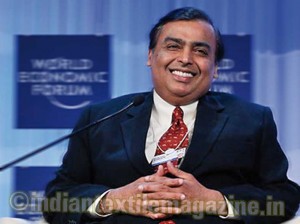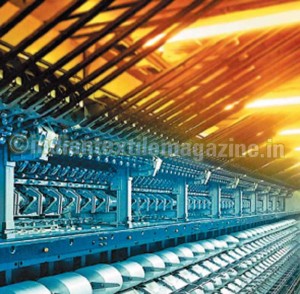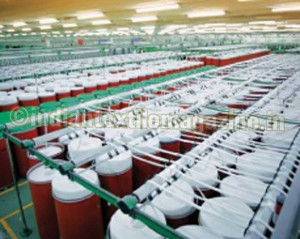
Reliance Industries Ltd. (RIL) has just commissioned its new polyester filament yarn (PFY) facility at Silvassa. With this, RIL’s total PFY capacity, including the Malaysian facilities, will be in excess of 1.5 MMTPA. This expansion further strengthens the group position as the world’s largest PFY producer.
The PFY plant at Silvassa is the most automated and one of the most environment-friendly plants globally. It is co-located with RIL’s existing texturizing facility at Silvassa, eliminating the packaging and logistics costs. The entire production from this facility has been successfully placed in the domestic and international markets.
With the commissioning of this ultra-modern PFY facility, Reliance’s total PFY capacity, including the facilities at Recron, the wholly-owned subsidiary in Malaysia, is now in excess of 1.5 MMTPA.
This, coupled with integration with PTA, will make the Silvassa facility amongst the lowest cost PFY producing sites globally. Its commissioning also marks the commencement of RIL’s mega petrochemical expansion programme.
RIL achieved a turnover of Rs. 401,302 crores ($67 billion) for the year ended March 31, 2014, an increase of 8.1 per cent, as compared to Rs. 371,119 crores in the previous year. Higher prices accounted for 7.7 per cent growth in revenue, while increase in volumes accounted for 0.4 per cent growth in revenue. Exports were higher by 15.3 per cent at Rs. 275,825 crores ($46 billion) against Rs. 239,226 crores in FY 2012-13.
 Commenting on the results, Mr. Mukesh D. Ambani, RIL Chairman and Managing Director, said: “FY 2013-14 was a satisfying year for RIL. Refining business delivered the highest-ever profits with a sharp recovery in GRMs towards the end of the year. Petrochemical earnings grew sharply with margin expansion across polymers and downstream polyester products. While we continue to face technical challenges in growing domestic upstream production, the US shale gas business grew significantly during the year and has become a material contributor to our earnings. Retail business has turned around and is now India’s largest retail chain. We have also accelerated efforts to roll out our state-of-the-art 4G services across the country which will add an exciting new dimension to our consumer facing service offerings.”
Commenting on the results, Mr. Mukesh D. Ambani, RIL Chairman and Managing Director, said: “FY 2013-14 was a satisfying year for RIL. Refining business delivered the highest-ever profits with a sharp recovery in GRMs towards the end of the year. Petrochemical earnings grew sharply with margin expansion across polymers and downstream polyester products. While we continue to face technical challenges in growing domestic upstream production, the US shale gas business grew significantly during the year and has become a material contributor to our earnings. Retail business has turned around and is now India’s largest retail chain. We have also accelerated efforts to roll out our state-of-the-art 4G services across the country which will add an exciting new dimension to our consumer facing service offerings.”
Polyester chain
The global polyester industry was affected by the uncertainty prevailing in the upstream feedstock industry. Lack of definite direction about market balance and consequent price directions impacted the polyester markets and resulted in a cautious stance. Continued capacity growth added to the industry overhang and lowered operating rates during the year. PET producers rationalised operating rates and were able to improve margins by 29 per cent over the previous year. Downstream polyester (PFY/PSF) margins were stable on account of weak intermediate markets.
Feedstock prices remained volatile, particularly in the second half of the year. The PX market was dislocated due to lack of clarity on the commissioning schedule of new plants. As a result, contract prices remained unsettled several times during the year. Margins declined from the previous year as naphtha prices remained firm, and acceptability of PX prices by the strained PTA sector remained weak.
 PTA margins continued to be impacted by overcapacity, specially in China, and consequently operating rates remained low. FY14 MEG deltas were marginally lower due to firm ethylene prices and high inventory levels at ports in China.
PTA margins continued to be impacted by overcapacity, specially in China, and consequently operating rates remained low. FY14 MEG deltas were marginally lower due to firm ethylene prices and high inventory levels at ports in China.
Domestic polyester demand grew by six per cent during the year led by fully drawn yarn (FDY) and PET. FDY witnessed the highest growth rate of 17 per cent owing to increased applications and newer areas of consumer demand. PET demand increased with demand for expansion in the downstream beverage segments, but was slower due to the early and prolonged monsoon. With the depreciation of the Indian rupee during the year textile exports increased for most categories.
For the year, production of fibre intermediates (PX, PTA and MEG) was around 4.7 MMT, marginally lower compared to the previous year. Polyester (PFY, PSF and PET) production was at 1.6 MMT, up one per cent on a y-o-y basis.